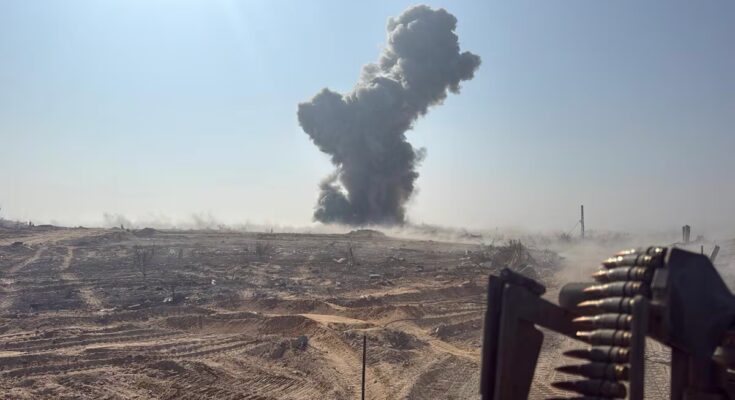The president of the United States, Donald Trump, was the protagonist of the summit in Egypt on 13 October in which he signed the truce for Gaza and in which he boasted of having put an end to 3,000 years of conflict in the region. Far from the walls of the Oval Office that have heard him repeat the same idea ever since, the reality on the ground in the Strip is that of residents deprived of basic rights and needs, and that of a ceasefire with a path to peace so unlikely that Kim Ghattas, an expert on the region, writes in The Financial Times about the “dissonance between what Trump thinks he will achieve” and reality.
The first phase of Trump’s roadmap is virtually complete. Hamas returned nearly all of the 48 living and dead hostages it had in its possession, and Israel reciprocated by returning the remains of 315 Palestinian prisoners as of Monday, of which only 91 could be identified because they were fragmented or decomposed. All this while the main hostilities have ceased and the Israeli authorities have allowed a slight increase in the humanitarian flow, although far from what the agreement requires and the absence of restrictions that the International Court of Justice requires.
Now is the time to establish the future, in which Israel – which aspires to maintain the occupation – and Hamas – which aspires to a Palestinian state – are irreconcilable. The second tranche of Trump’s proposal, yet to be agreed upon, brings together general principles that loosely link the disarmament of militias and progress in the Israeli withdrawal with the deployment of an international force and the emergence of a governance model with foreign participation. But several things could go wrong.
The plan could stall if the United States fails to recruit volunteer countries to join the international force (ISF). The 15 members of the UN Security Council have been negotiating since last Wednesday a proposed American resolution that would give the ISF a mandate and a mission.
The first phases of the cessation celebrated in Sharm el Sheikh left a Gaza without massive bombing, but in conflict – Ghattas describes it as a “controlled war” –. They also left two million Palestinians languishing inside the Yellow Line, a new wall that encapsulates them in less than half of the Strip, often described as the most densely populated place on the planet.
Meanwhile, east of that barrier, which will remain until progress is made in disarming Hamas, 53% of the enclave is a desert of rubble off limits to Palestinians and patrolled by Israeli soldiers. Shaina Low, of the Norwegian Refugee Council, tells EL PAÍS that one and a half million inhabitants of Gaza need help to have a roof over their heads.
Despite the truce, Israeli shrapnel has killed at least 242 Palestinians, Gaza authorities said Tuesday, and the Israeli military reports sporadic attacks by Palestinian fighters. The Trump administration claims that the clashes are predictable, but its members do not take their eyes off their Israeli partner. Two of them – the special envoy to the region, Steve Witkoff, and Trump’s son-in-law and adviser, Jared Kushner – were in Israel again on Tuesday to advance the project.
The White House is aware that the truce presents obstacles that could sink it before it becomes permanent. In the near future, Hamas has yet to return the remains of four deceased hostages – three Israelis, one Thai – while the prisoners’ families are calling on Israel to abandon the ceasefire if there are bodies to return. At the same time, Kushner is reportedly intervening in negotiations to offer safe passage to 200 Hamas fighters trapped in the Israeli-controlled half of Gaza when Orit Strock, Israel’s settlement minister, demands that they not be allowed to flee.
The leap to the second phase
The candidate countries to join the ISF are confident that the future resolution – which the United States expects in weeks – will answer what Trump’s proposal leaves up in the air: who will disarm Hamas? The Palestinian militia still has tens of thousands of fighters, many of them young and inexperienced recruited during the conflict.
“Where does the ISF fit into the disarmament continuum? Isn’t that the crux of the matter?” asks David Schenker, an analyst at the Washington Institute for Near East Policy and Trump’s first-term advisor. “These states do not want their citizens to be in danger or to be the ones to disarm Hamas,” he argues for the Israeli newspaper Haaretz.
Although the resolution exempts the ISF from confrontation with Hamas, disappointment in negotiations over the militias’ handover of their arsenal would induce Israeli heavy-handedness. Netanyahu reminds us of this at every opportunity, Trump does not rule out this scenario, and Kobi Michael, senior researcher at the Israel Institute for National Security Studies and the Misgav Institute for National Security and Zionist Strategy, sees it as inevitable.
“Hamas will not disarm,” he explains on the phone to EL PAÍS. “Israel gives the United States space to try peacefully. I wish them good luck. When they come to the conclusion that there is no partner on the other side, I assume they will legitimize the use of Israeli force.”
The most likely scenario is stagnation. “The Israeli army will remain deployed” in the 53% of the enclave east of the Yellow Line, “which will be free of Palestinians”, and will wait “for the right moment to resume the offensive against Hamas”. Point 16 of Trump’s plan allows Israel to remain in the enclave until “Gaza no longer represents a threat”, an interpretable element that it uses in Lebanon to bomb on a daily basis despite the truce.
Real estate projects
Another element that can deteriorate the path to stability is the desire to further divide Palestinians through real estate projects. US Vice President JD Vance and advisor Kushner anticipated in October from Israel that reconstruction could begin immediately in the Israeli-controlled half of Gaza, while the other side denied this. “The idea,” Vance said, is to “start rebuilding” in that area and “get Gazans to live there and have good jobs and safety and comfort.”
The project, which probably involved Witkoff and Kushner this Monday in Israel, is coming to fruition. The United States plans to build homes for 25,000 people, which will be a pilot test of something called “Secure Alternative Communities,” according to American media. Atlantic on Monday. Israeli intelligence would veto residents based on their ties to Hamas using unknown criteria.
The idea is reminiscent of the Riviera delivered by Trump in February. Point 10 of the plan calls for the development of Gaza with experts who have promoted “miracle cities”, and the proposed resolution presented to the UN grants the Peace Board – which would oversee the enclave’s government and over which Trump will preside – authority in reconstruction, according to Reuters, which had access to the text.
Tamir Hayman, former head of Israeli military intelligence, sees it as the same occupation in a different package. “Every suspect who crosses (to the other side) should be monitored 24 hours a day and checkpoints“, he declares The New York Times. “Hamas would try to infiltrate and launch attacks from within as resistance to the occupation.”
The secretary general of the United Nations Palestinian refugee agency (UNRWA), which the United States and Israel want to ban from entering the Strip, called this Monday that the yellow line does not become “a greater fragmentation” in Gaza or further divide Gazans from West Bank citizens.



